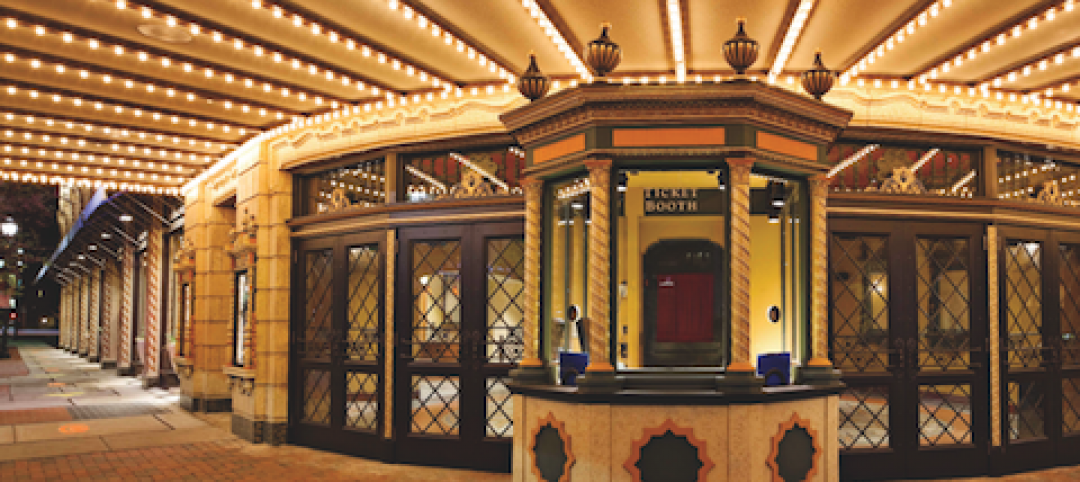 |
|
Design for the Holocaust and Human Rights Center of Maine is representative of a flower in bloom, complete with petals that shelter the circular exhibit space. The center connects to the Bennett Katz Library. Photos: Shepley Bullfinch |
The Holocaust and Human Rights Center of Maine was founded in 1985, but the organization didn't have a permanent home until May 2008. That's when the Michael Klahr Center, which houses the HHRC, opened on the Augusta campus of the University of Maine.
The design, by Boston-based architects Shepley Bulfinch Richardson & Abbott, was selected from among more than 200 entries in a university-sponsored competition. The winning project, a conceptualized flower in bloom, was created by a group of young architects at Shepley Bulfinch who imagined four petal-like forms growing out of the ground—symbolic of the seeds of democracy and freedom.
“There are still so many human rights issues out there today, so the flower blossoms are representative of new life coming back when conditions are right,” says Angela Watson, a principal at Shepley Bulfinch and mentor to the young architects.
 |
|
The Building Team utilized BIM to check the demands and capabilities of the petal forms and determine the proper petal radii, which cut the cost of bending the shell steel by half. The finished petals are clad in copper. |
It was Watson who introduced the HHRC project to the firm. When she learned of the University of Maine's design competition back in 2004, she organized a separate in-house competition as a way to give the firm's young bloods a chance to “flex their design muscles,” as she put it. The entire firm voted, and the two winning designs were entered in the HHRC competition, with one taking the prize.
At 6,300 sf, the Michael Klahr Center isn't a large building. The space is apportioned throughout a single level that includes a circular exhibit space in the center as well as offices and education space. However, its sculptural forms were complex enough for the Building Team, which included structural engineer Simpson Gumpertz and Heger of Waltham, Mass., to experiment with BIM.
Not a big deal now, but BIM was fairly new in 2004 when design began, turning this project into a BIM pilot for Shepley Bulfinch. The Building Team used BIM to explore many different construction options, including cast-in-place concrete, glulam wood beams, and steel. They found that cast-in-place would push the project over the $1.8 million budget cap and glulam would make the petals too thick. Their BIM model helped them decide that steel framework was the most efficient and economical solution.
Steel construction enabled some portions of the building to be shop fabricated, which saved time. General contractor Wright-Ryan Construction, Portland, Maine, cut construction time even more by framing large portions of the small building using wide-flange noncomposite steel beams and columns, with the lateral load system consisting of structural steel concentrically braced frames with hollow structural section (HSS) brace members.
But it was the complex design of the steel petals that really tested the Building Team's mettle.
The SGH structural engineering team developed an innovative structural system that consisted of a grid of HSS sections using curved HSS 8x8s as the ribs along the meridians of the spherical sections of the petals and straight HSS 4x4s along the parallels of latitude of the pedals. The HSS grids, braced and moment-connected in-plane, allowed the petals to act as shells. Three-inch-diameter structural steel columns pierced the petals and provided additional structural support. The BIM model enabled the team to check the demands and capabilities of the petals and determine the proper petal radii, which cut the cost of bending the shell steel by half.
Wood-framed box beams (made of 2x4s and plywood) were incorporated into the spans between the rib framing; this allowed the four petals to be sheathed in plywood, over which the standing seam copper roof panels were installed.
“This building is the perfect story,” says Watson. “It's a unique design from a young, talented team that overcame challenges of budget, schedule, and material and created a place that will have lasting impact.”
Related Stories
| Oct 12, 2010
Holton Career and Resource Center, Durham, N.C.
27th Annual Reconstruction Awards—Special Recognition. Early in the current decade, violence within the community of Northeast Central Durham, N.C., escalated to the point where school safety officers at Holton Junior High School feared for their own safety. The school eventually closed and the property sat vacant for five years.
| Oct 12, 2010
Richmond CenterStage, Richmond, Va.
27th Annual Reconstruction Awards—Bronze Award. The Richmond CenterStage opened in 1928 in the Virginia capital as a grand movie palace named Loew’s Theatre. It was reinvented in 1983 as a performing arts center known as Carpenter Theatre and hobbled along until 2004, when the crumbling venue was mercifully shuttered.
| Oct 12, 2010
Gartner Auditorium, Cleveland Museum of Art
27th Annual Reconstruction Awards—Silver Award. Gartner Auditorium was originally designed by Marcel Breuer and completed, in 1971, as part of his Education Wing at the Cleveland Museum of Art. Despite that lofty provenance, the Gartner was never a perfect music venue.
| Oct 12, 2010
The Watch Factory, Waltham, Mass.
27th Annual Reconstruction Awards — Gold Award. When the Boston Watch Company opened its factory in 1854 on the banks of the Charles River in Waltham, Mass., the area was far enough away from the dust, dirt, and grime of Boston to safely assemble delicate watch parts.
| Oct 12, 2010
Cuyahoga County Soldiers’ and Sailors’ Monument, Cleveland, Ohio
27th Annual Reconstruction Awards—Gold Award. The Cuyahoga County Soldiers’ and Sailors’ Monument was dedicated on the Fourth of July, 1894, to honor the memory of the more than 9,000 Cuyahoga County veterans of the Civil War.
| Oct 12, 2010
Building 13 Naval Station, Great Lakes, Ill.
27th Annual Reconstruction Awards—Gold Award. Designed by Chicago architect Jarvis Hunt and constructed in 1903, Building 13 is one of 39 structures within the Great Lakes Historic District at Naval Station Great Lakes, Ill.
| Oct 12, 2010
From ‘Plain Box’ to Community Asset
The Mid-Ohio Foodbank helps provide 55,000 meals a day to the hungry. Who would guess that it was once a nondescript mattress factory?
| Sep 22, 2010
Michael Van Valkenburg Assoc. wins St. Louis Gateway Arch design competition
Landscape architect Michael Van Valkenburgh and a multidisciplinary team of experts in “urban renewal, preservation, commemoration, social connections and ecological restoration” have been picked for the planning phase of The City+The Arch+The River 2015 International Design Competition.
| Sep 13, 2010
Second Time Around
A Building Team preserves the historic facade of a Broadway theater en route to creating the first green playhouse on the Great White Way.















